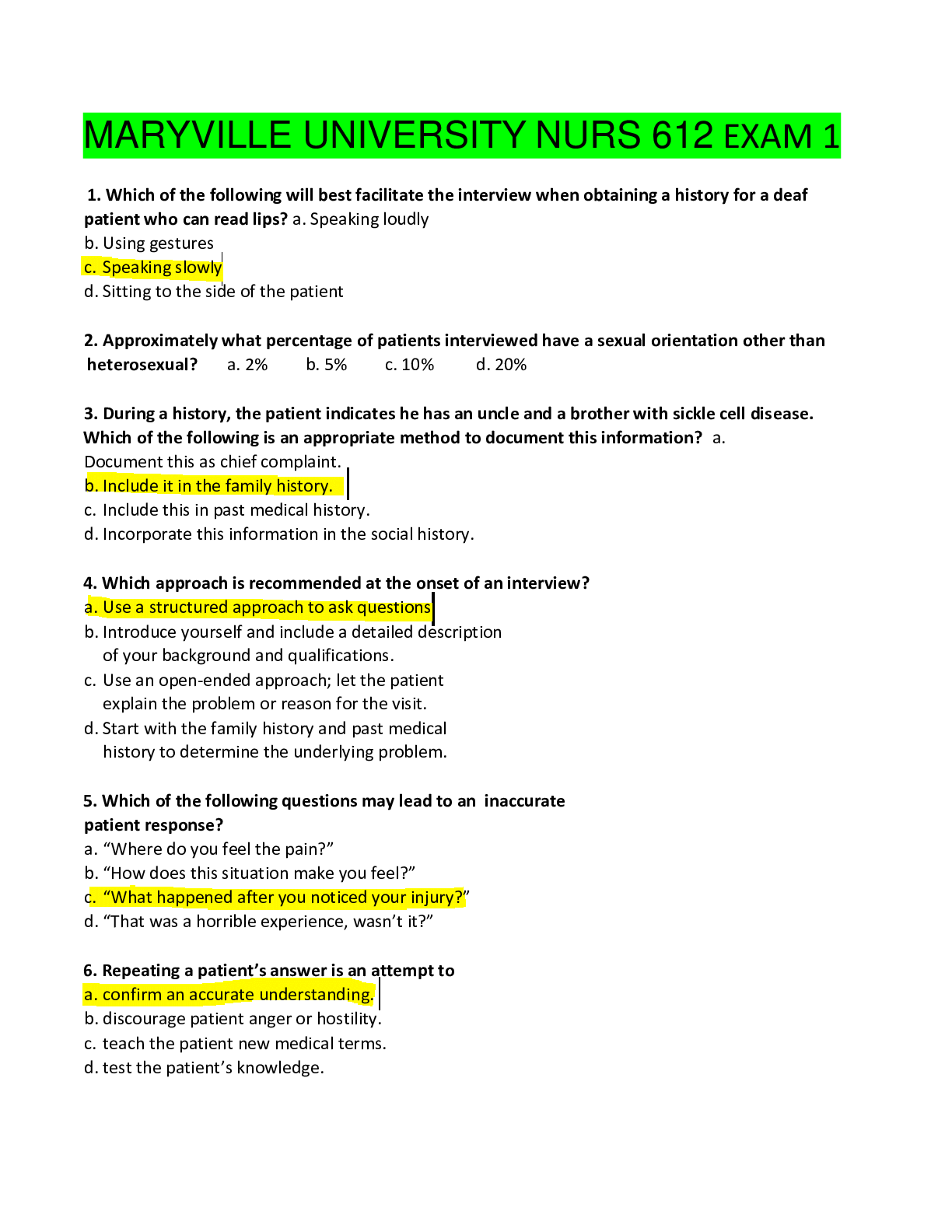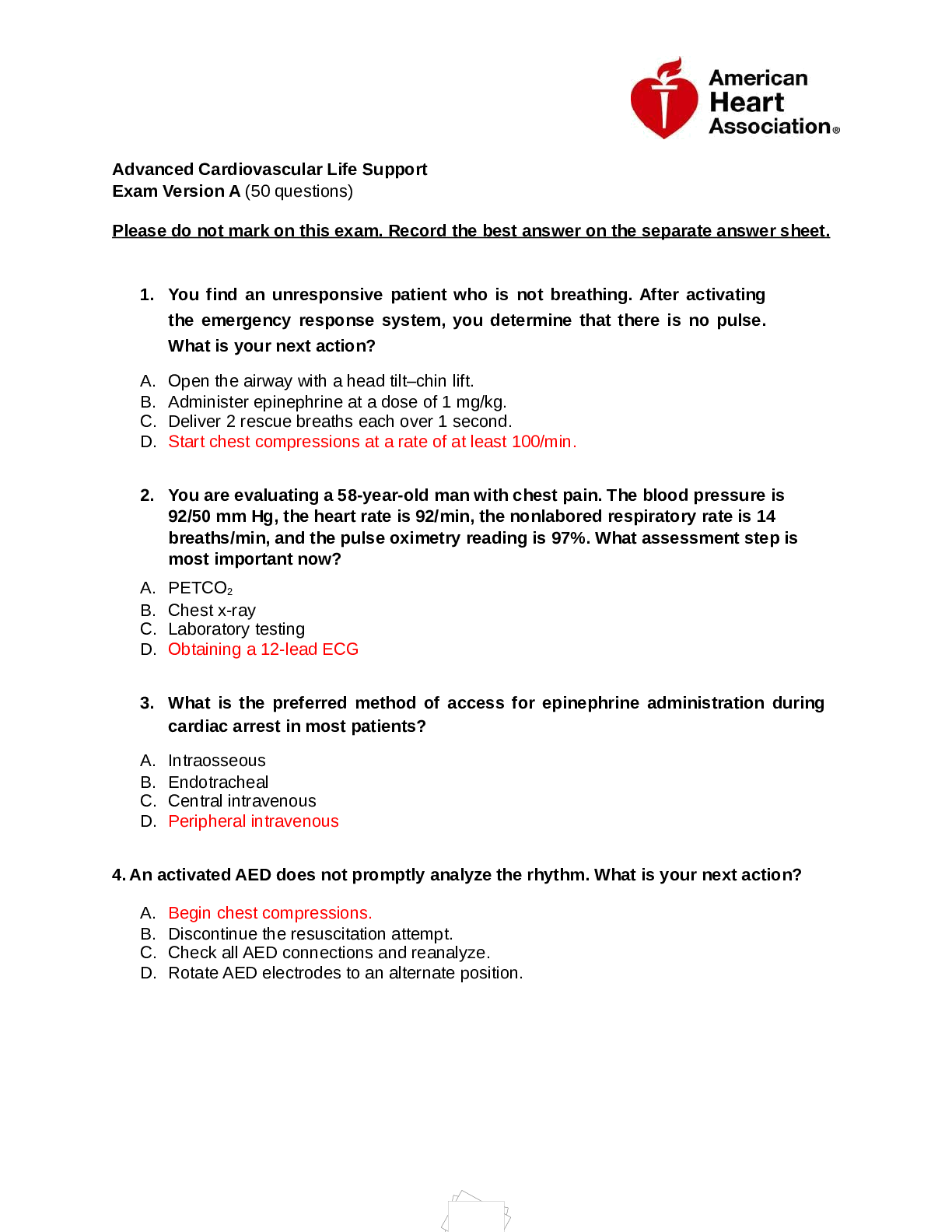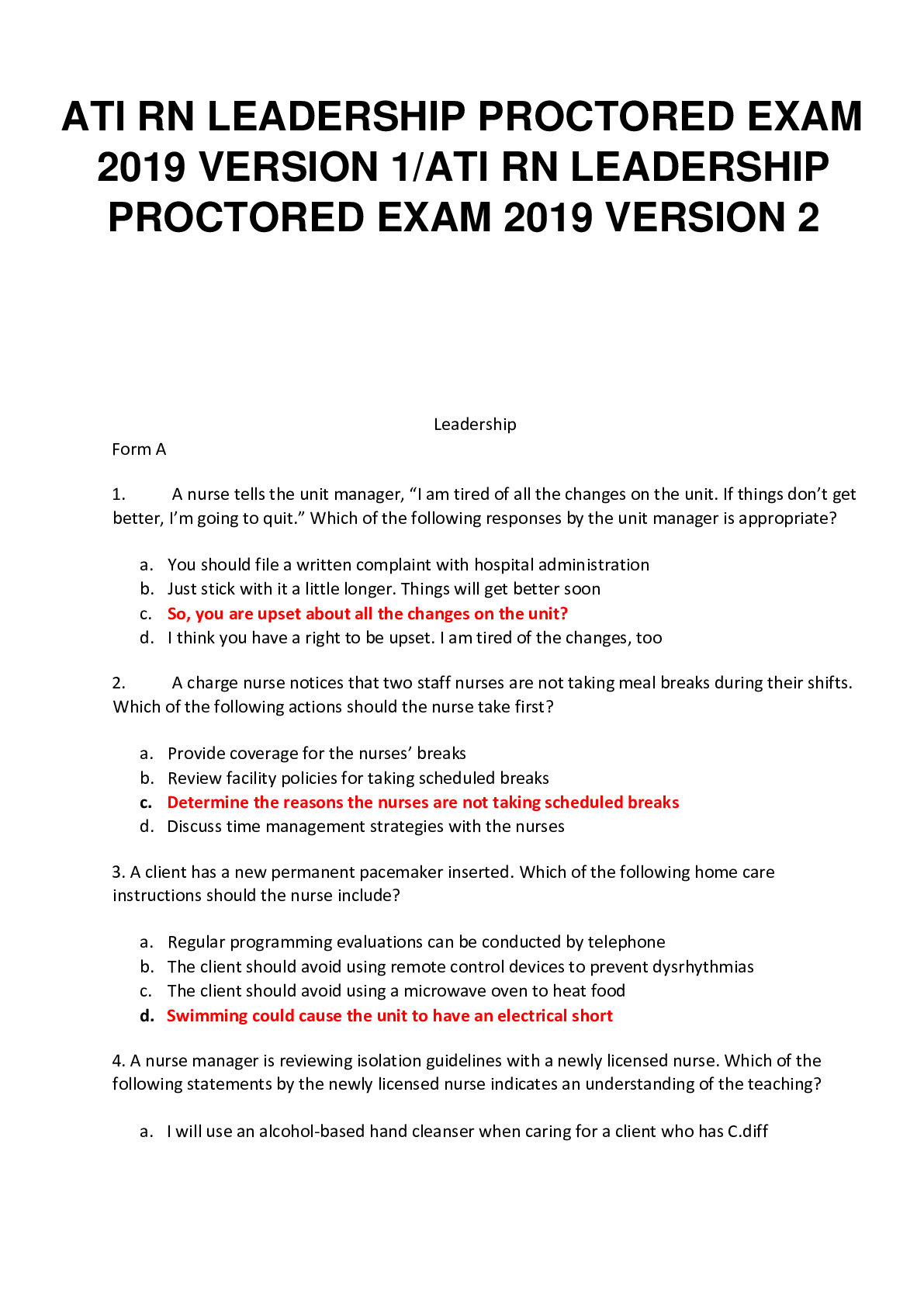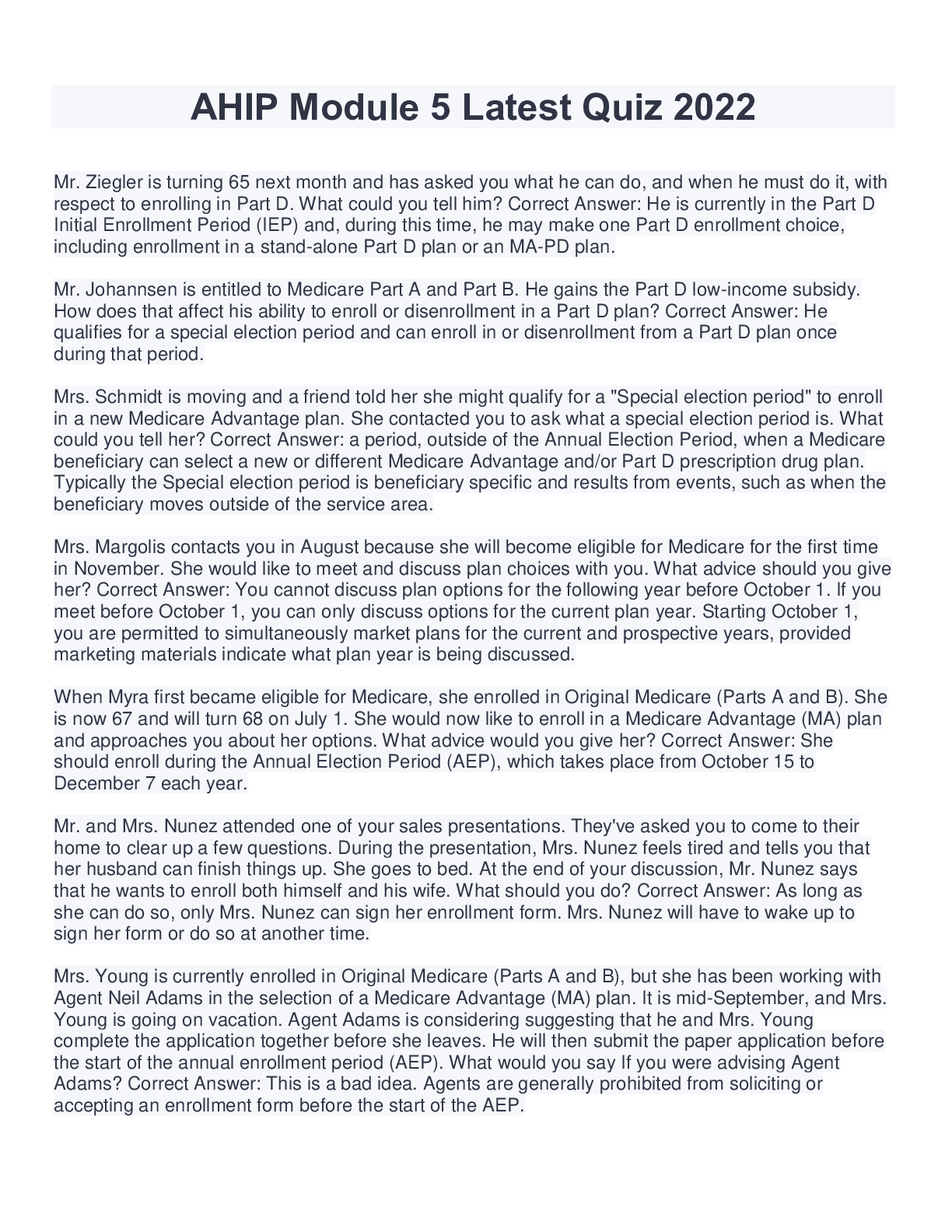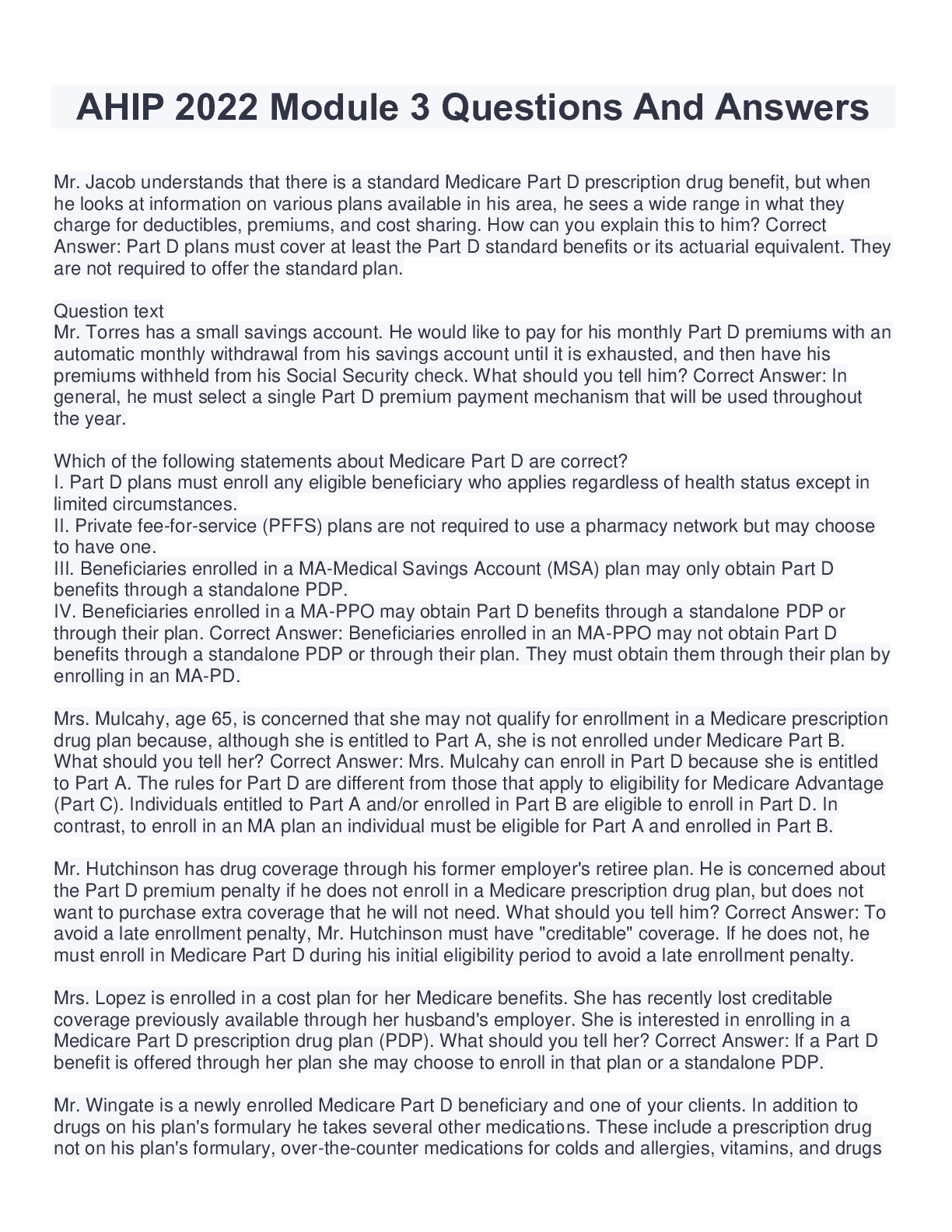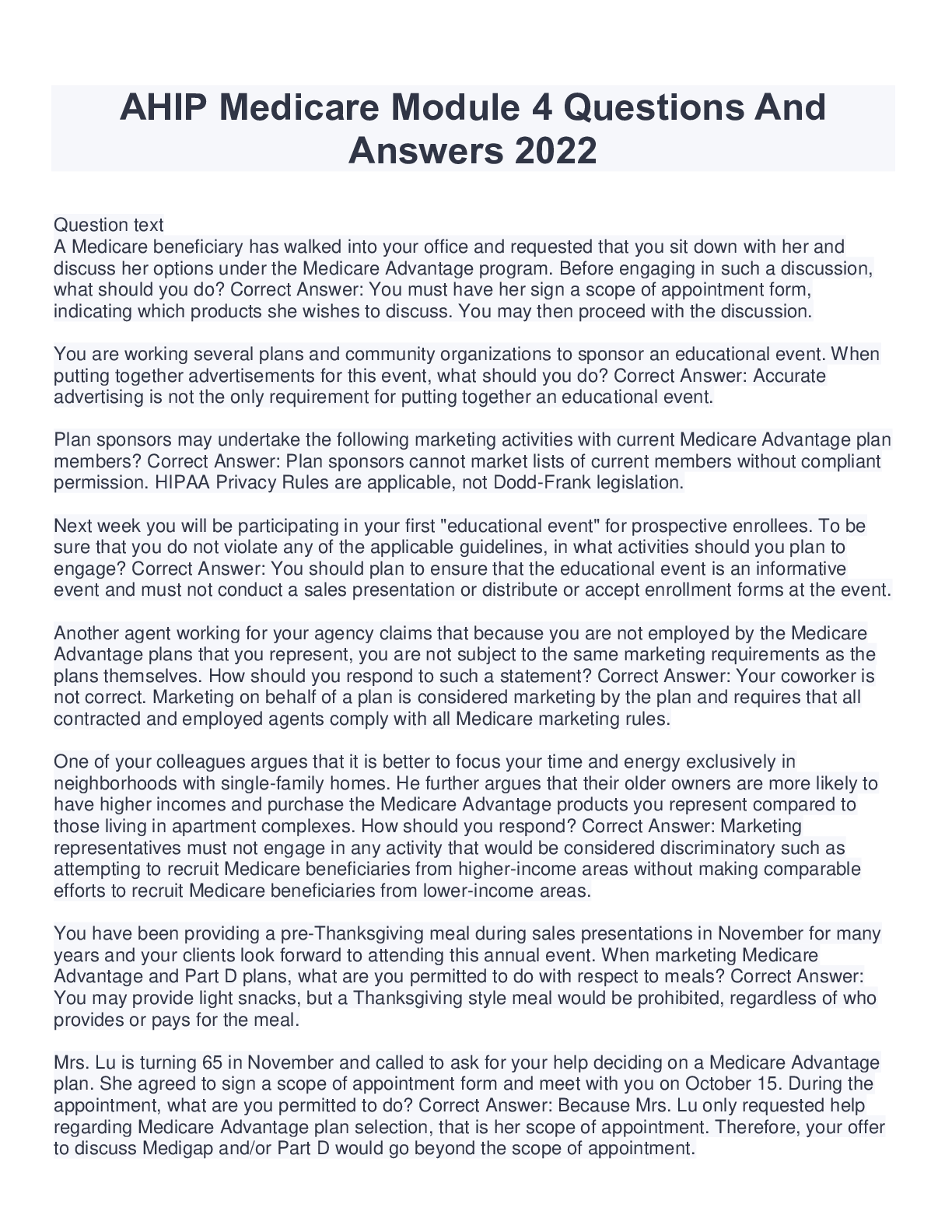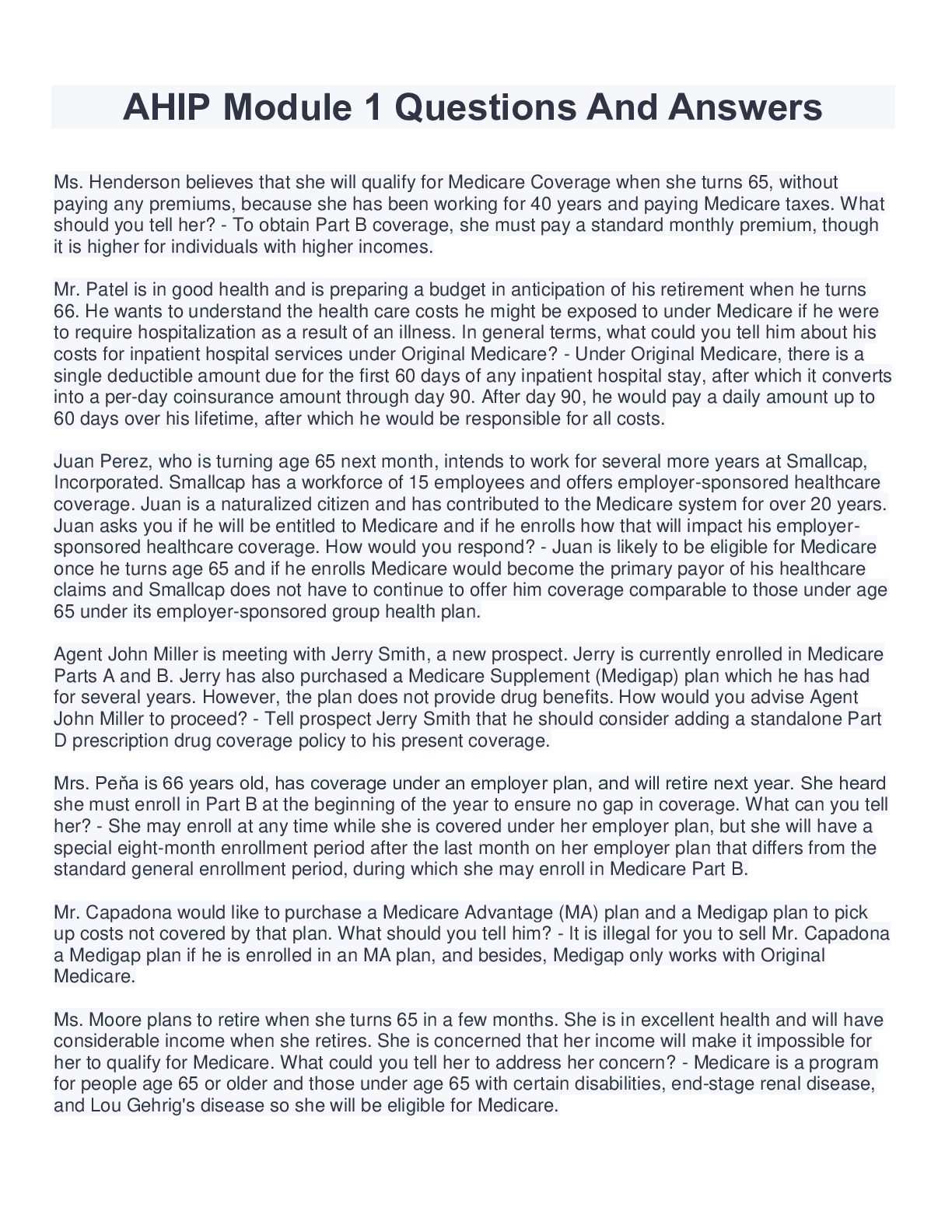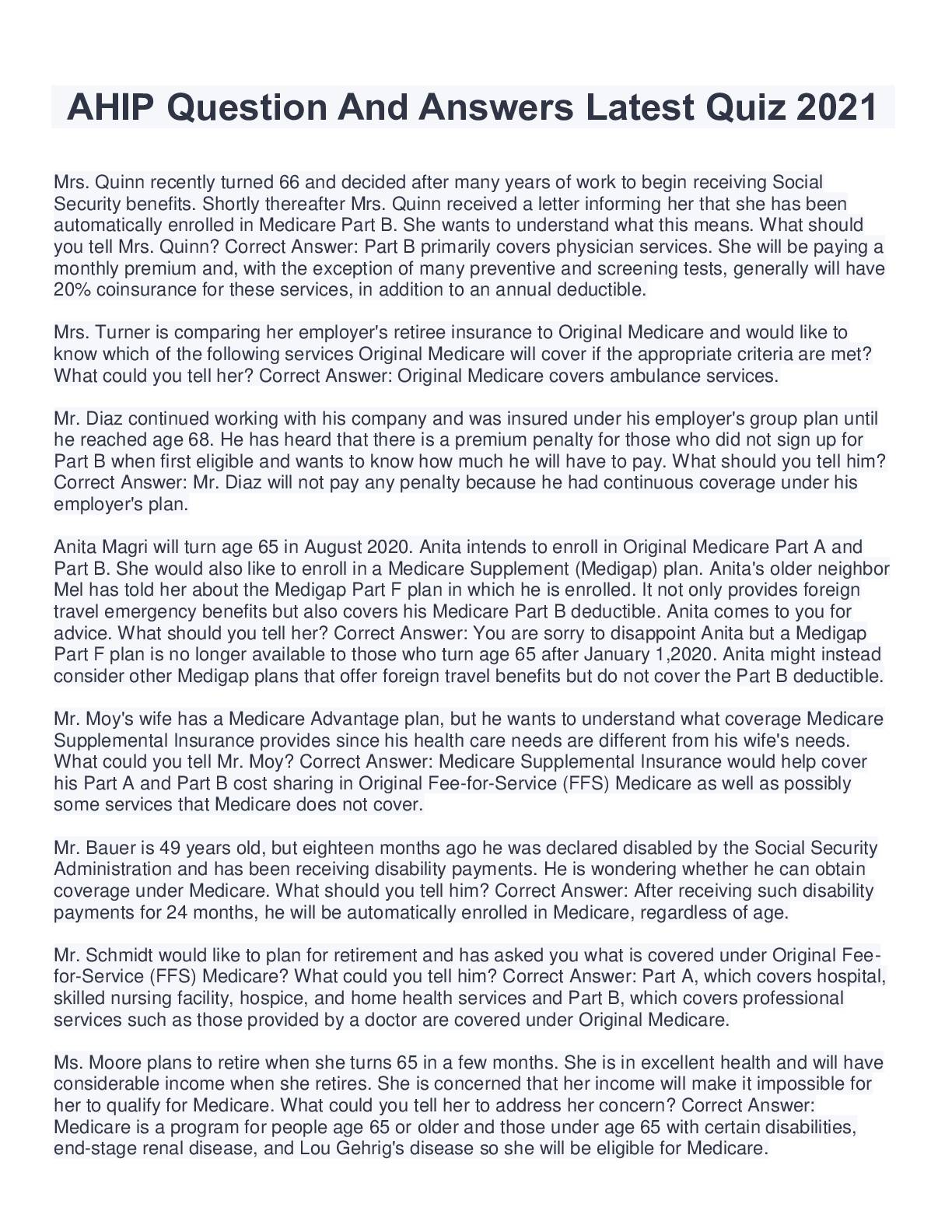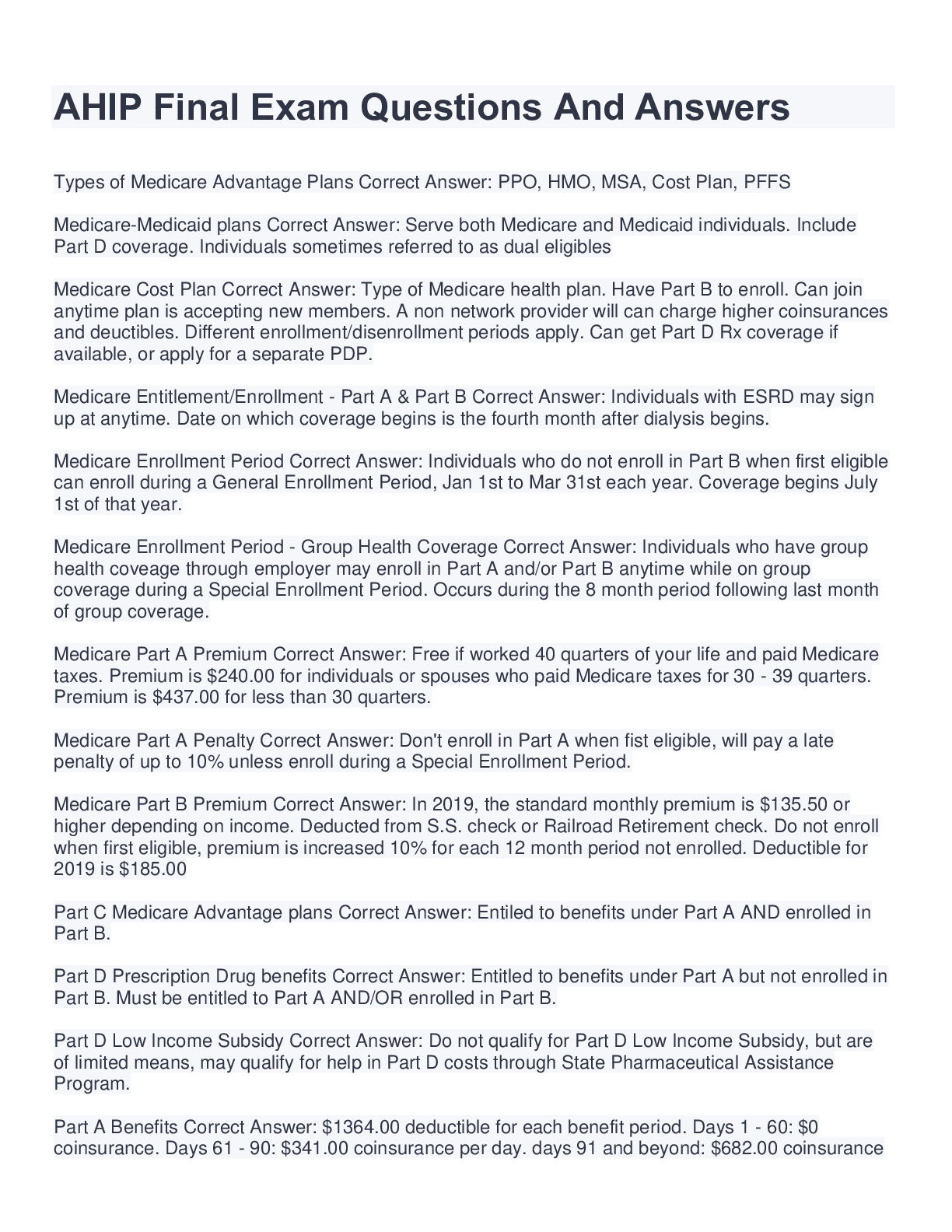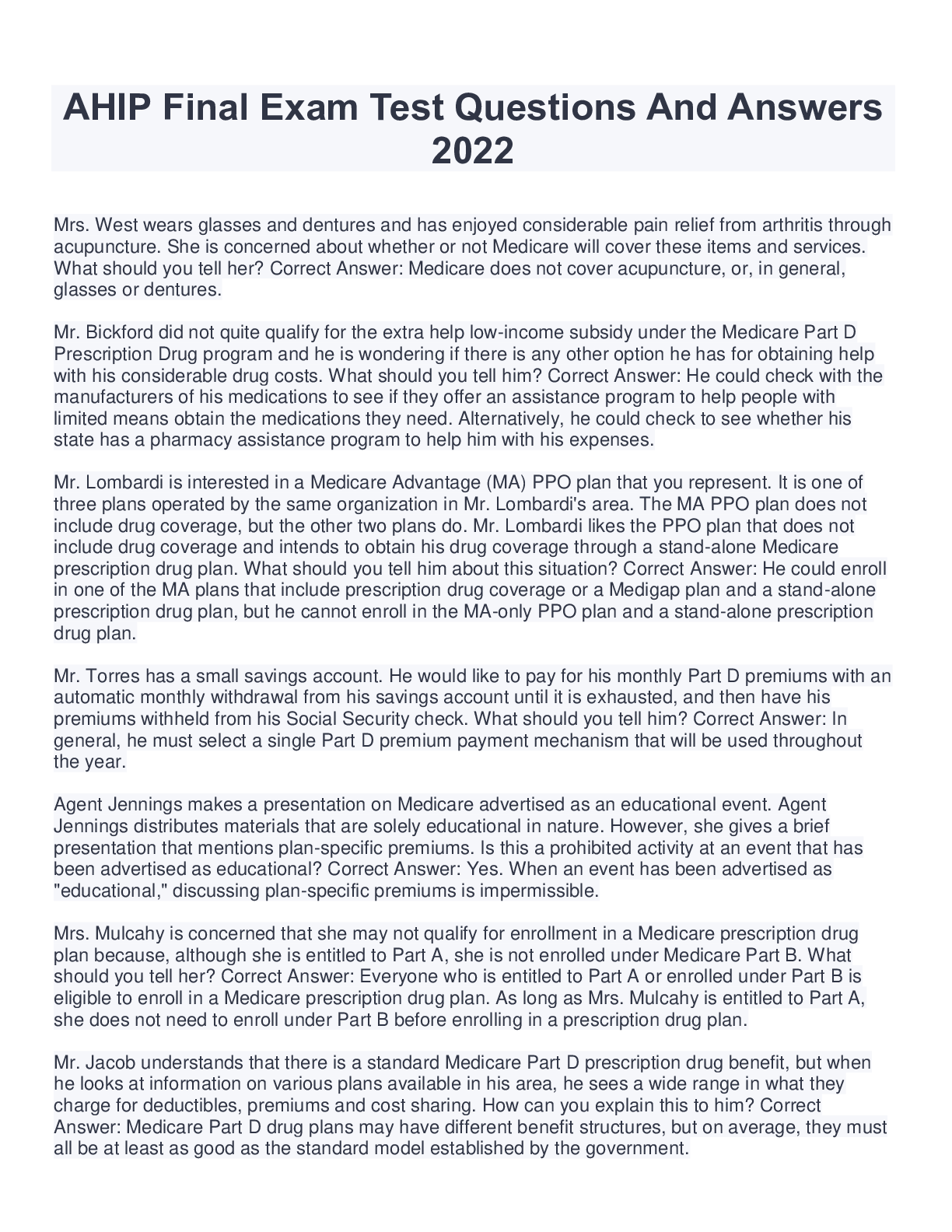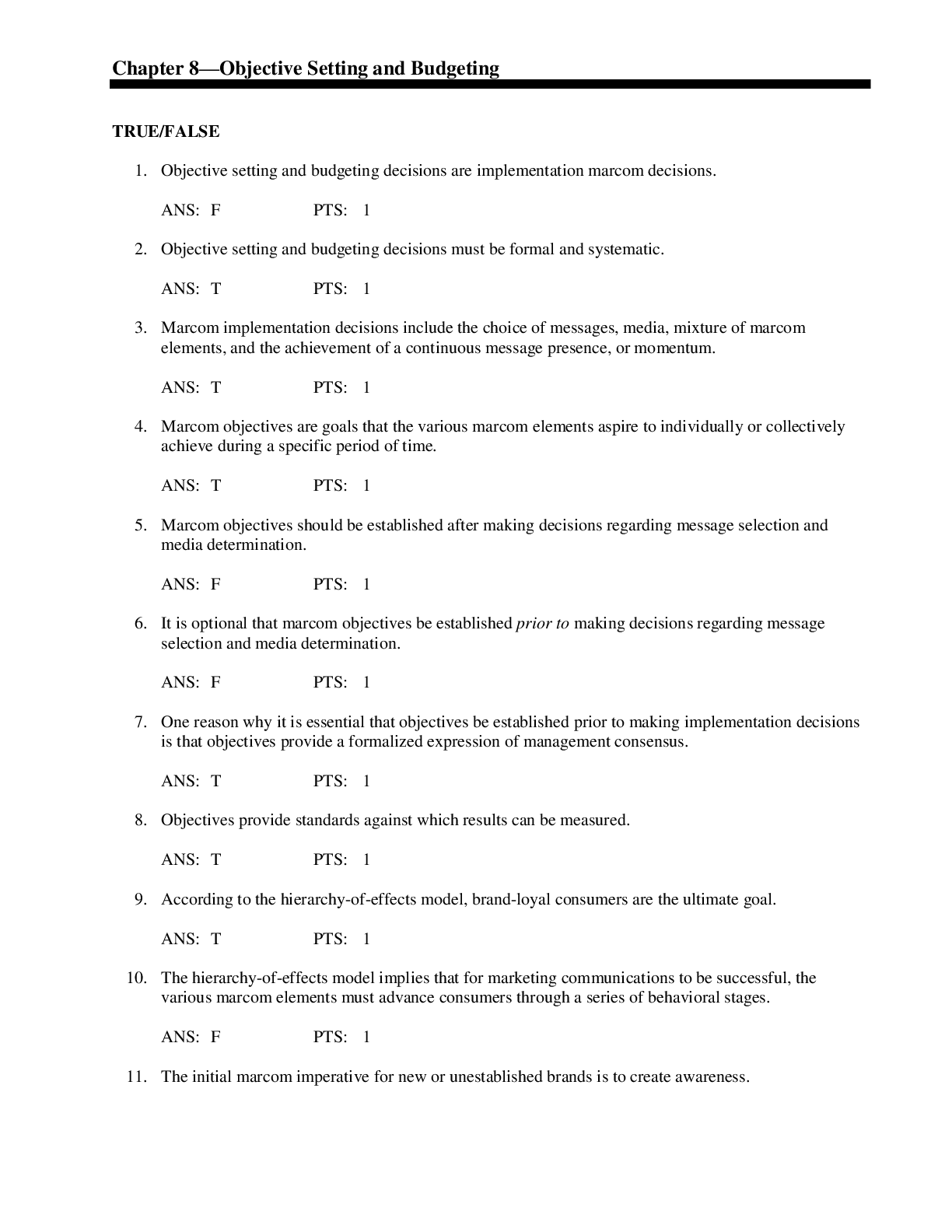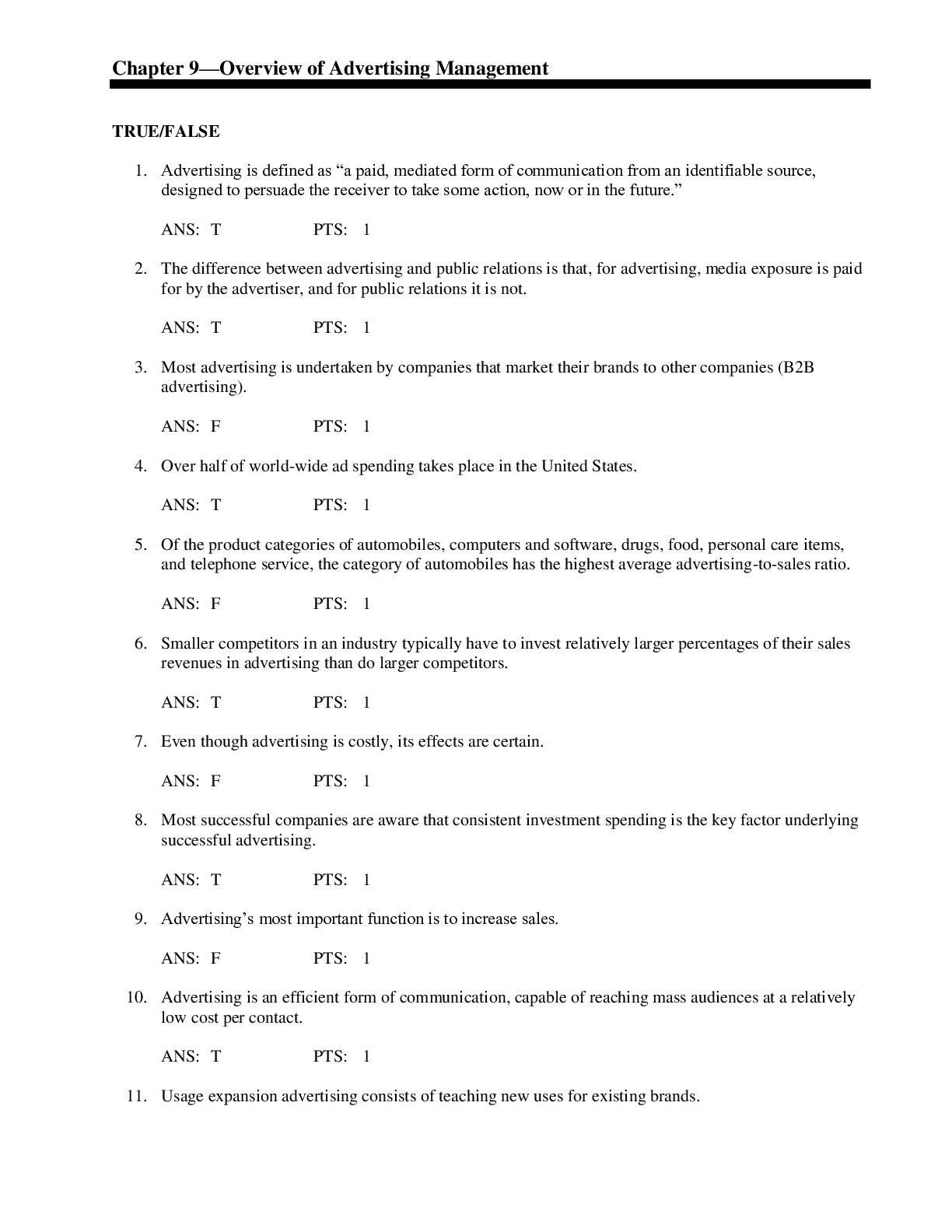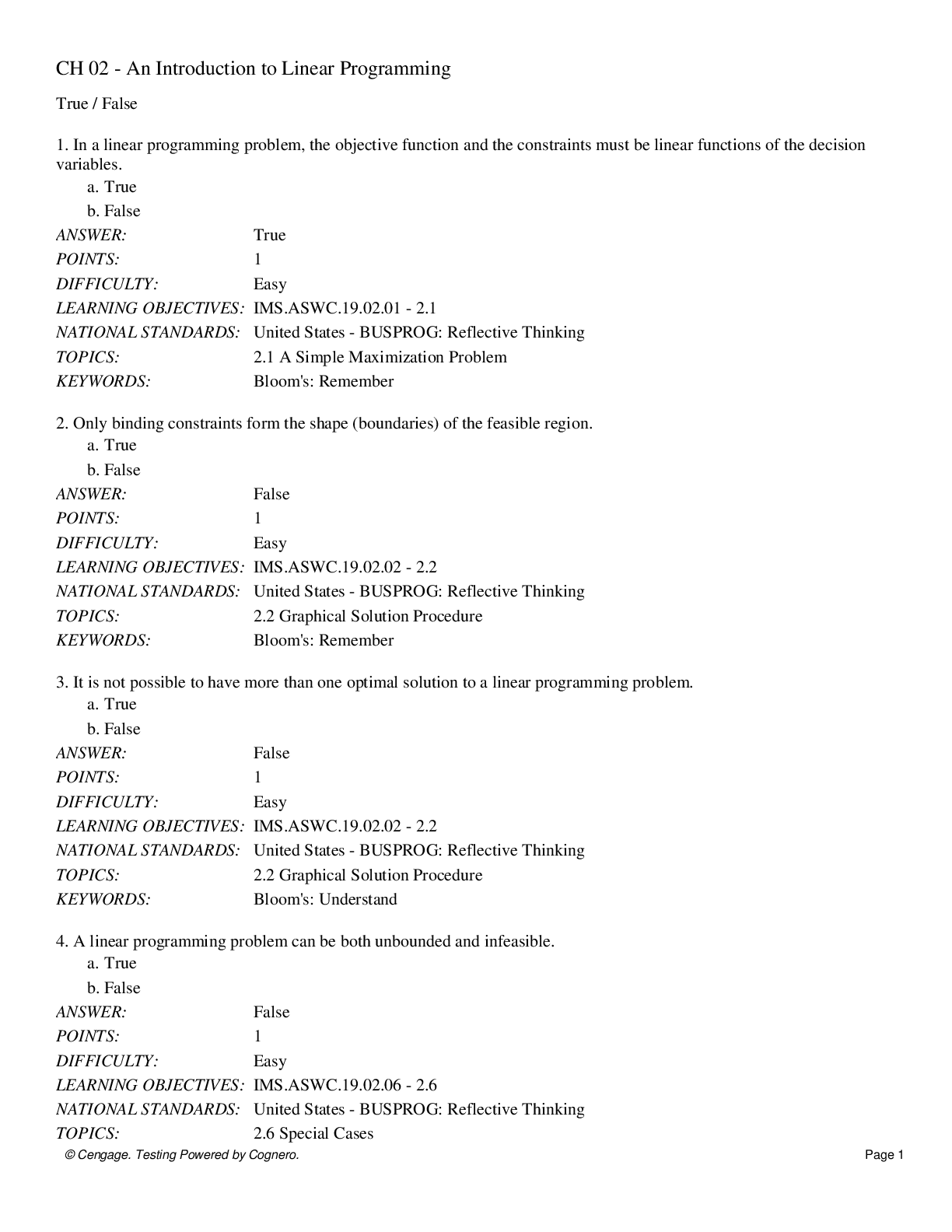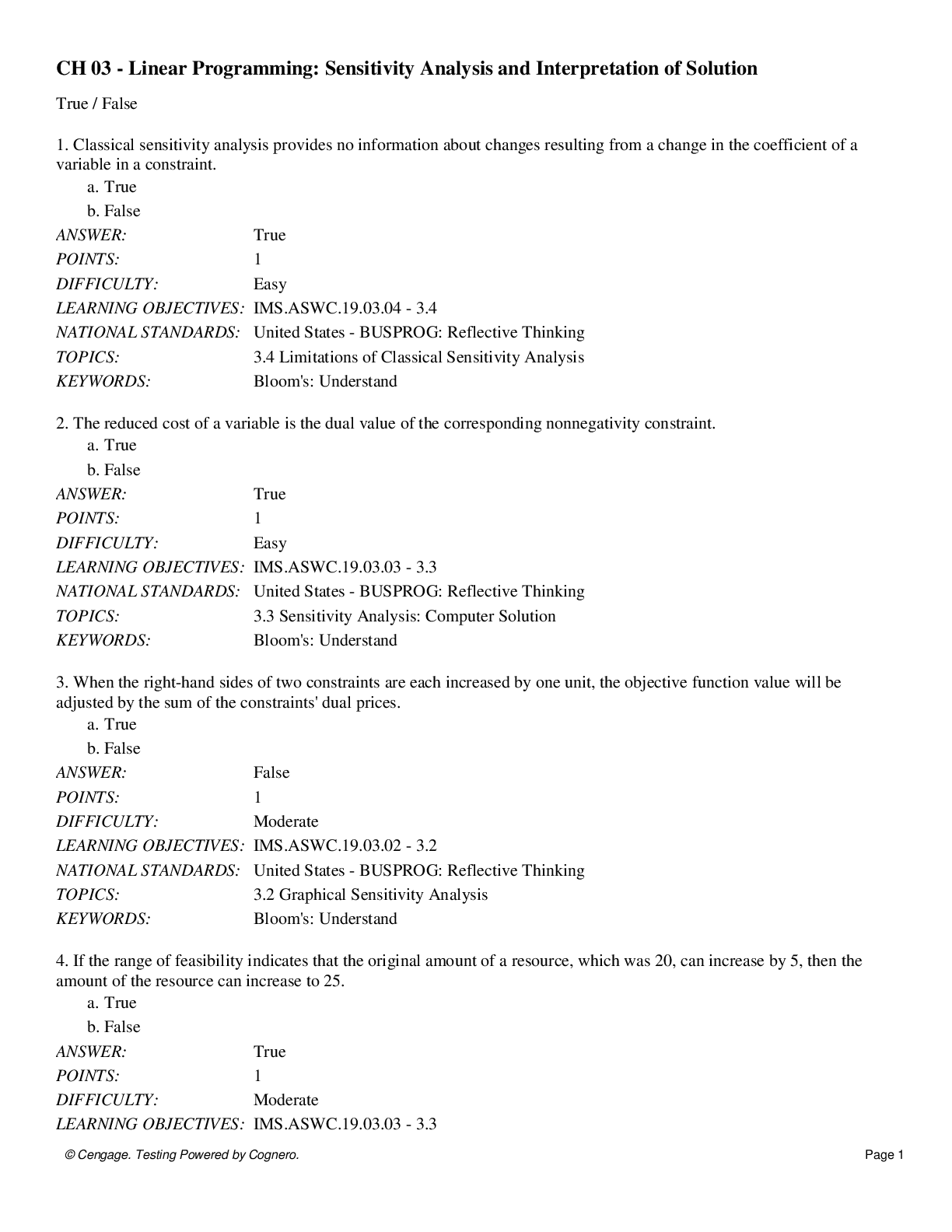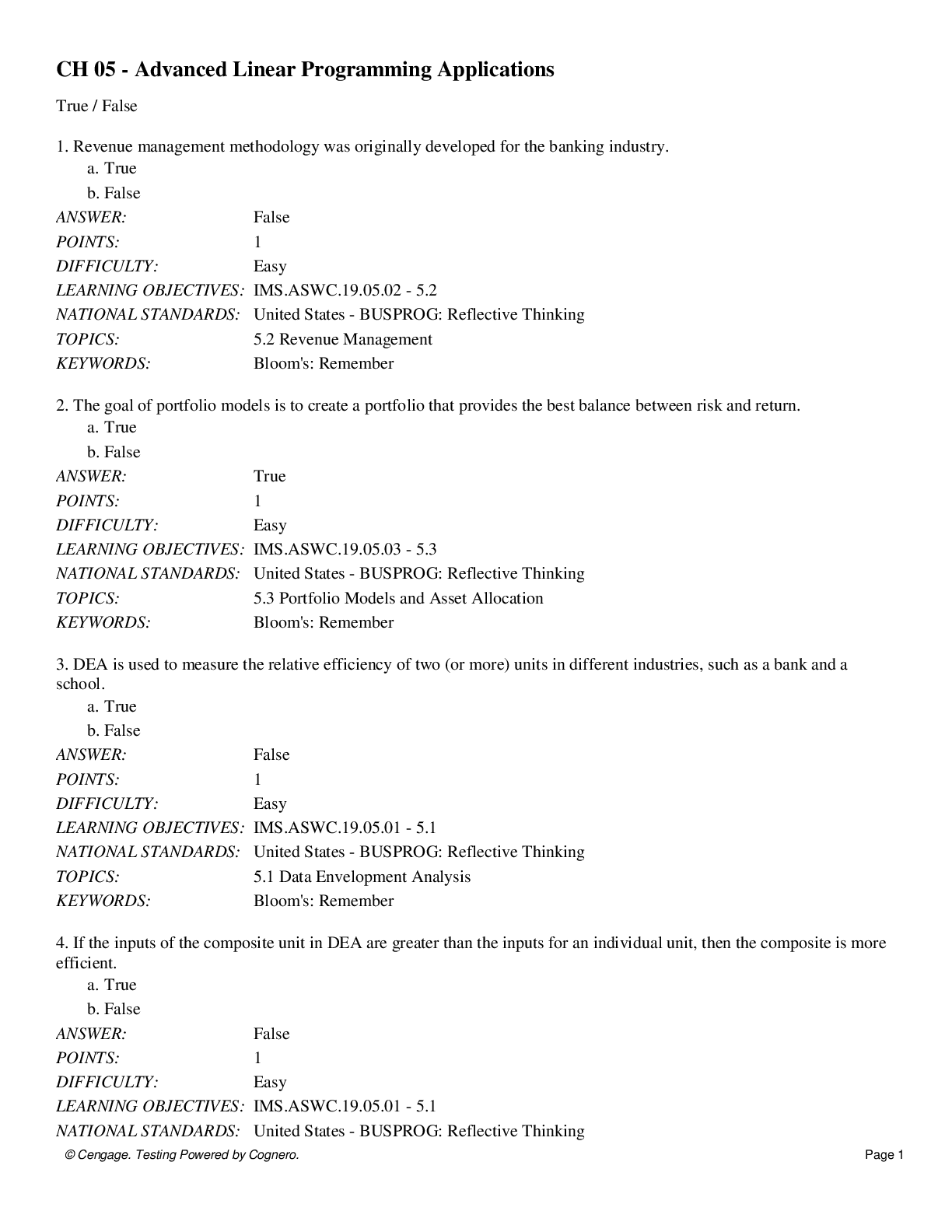Physiology > QUESTIONS & ANSWERS > PYSC 341-TEST 4 CARE OF PATIENTS WITH MUSCULOSKELETAL QUESTIONS AND ANSWERS (All)
PYSC 341-TEST 4 CARE OF PATIENTS WITH MUSCULOSKELETAL QUESTIONS AND ANSWERS
Document Content and Description Below
PYSC 341-TEST 4 CARE OF PATIENTS WITH MUSCULOSKELETAL QUESTIONS AND ANSWERS 1. A client has a bone density score of –2.8. What action by the nurse is best? a. Asking the client to complete a foo... d diary b. Planning to teach about bisphosphonates c. Scheduling another scan in 2 years d. Scheduling another scan in 6 months 2. A nurse is assessing an older client and discovers back pain with tenderness along T2 and T3. What action by the nurse is best? a. Consult with the provider about an x-ray. b. Encourage the client to use ibuprofen (Motrin). c. Have the client perform hip range of motion. d. Place the client in a rigid cervical collar. 3. A client has been advised to perform weight-bearing exercises to help minimize osteoporosis. The client admits to not doing the prescribed exercises. What action by the nurse is best? a. Ask the client about fear of falling. b. Instruct the client to increase calcium. c. Suggest other exercises the client can do. d. Tell the client to try weight lifting. Client Needs Category: Psychosocial Integrity 4. The nurse sees several clients with osteoporosis. For which client would bisphosphonates not be a good option? a. Client with diabetes who has a serum creatinine of 0.8 mg/dL b. Client who recently fell and has vertebral compression fractures c. Hypertensive client who takes calcium channel blockers d. Client with a spinal cord injury who cannot tolerate sitting up 5. A client has been prescribed denosumab (Prolia). What instruction about this drug is most appropriate? a. “Drink at least 8 ounces of water with it.” b. “Make appointments to come get your shot.” c. “Sit upright for 30 to 60 minutes after taking it.” 6. A client in a nursing home refuses to take medications. She is at high risk for osteomalacia. What action by the nurse is best? a. Ensure the client gets 15 minutes of sun exposure daily. b. Give the client daily vitamin D injections. c. Hide vitamin D supplements in favorite foods. d. Plan to serve foods naturally high in vitamin D. 7. A client is in the internal medicine clinic reporting bone pain. The client’s alkaline phosphatase level is 180 units/L. What action by the nurse is most appropriate? a. Assess the client for leg bowing. b. Facilitate an oncology workup. c. Instruct the client on fluid restrictions. d. Teach the client about ibuprofen (Motrin). 8. An older client with diabetes is admitted with a heavily draining leg wound. The client’s white blood cell count is 38,000/mm3 but the client is afebrile. What action does the nurse take first? a. Administer acetaminophen (Tylenol). b. Educate the client on amputation. c. Place the client on contact isolation. d. Refer the client to the wound care nurse. 9. A nurse is caring for four clients. After the hand-off report, which client does the nurse see first? a. Client with osteoporosis and a white blood cell count of 27,000/mm3 b. Client with osteoporosis and a bone fracture who requests pain medication c. Post-microvascular bone transfer client whose distal leg is cool and pale d. Client with suspected bone tumor who just returned from having a spinal CT 10. A client has a metastatic bone tumor. What action by the nurse takes priority? a. Administer pain medication as prescribed. b. Elevate the extremity and apply moist heat. c. Handle the affected extremity with caution. d. Place the client on protective precautions. 11. A hospitalized client is being treated for Ewing’s sarcoma. What action by the nurse is most important? a. Assessing and treating the client for pain as needed b. Educating the client on the disease and its treatment c. Handling and disposing of chemotherapeutic agents per policy d. Providing emotional support for the client and family 12. A client with bone cancer is hospitalized for a limb salvage procedure. How can the nurse best address the client’s psychosocial needs? a. Assess the client’s coping skills and support systems. b. Explain that the surgery leads to a longer life expectancy. c. Refer the client to the social worker or hospital chaplain. d. Reinforce physical therapy to aid with ambulating normally. 13. A client had a bunionectomy with osteotomy. The client asks why healing may take up to 3 months. What explanation by the nurse is best? a. “Your feet have less blood flow, so healing is slower.” b. “The bones in your feet are hard to operate on.” c. “The surrounding bones and tissue are damaged.” d. “Your feet bear weight so they never really heal.” 14. A client has scoliosis with a 65-degree curve to the spine. What action by the nurse takes priority? a. Allow the client to rest in a position of comfort. b. Assess the client’s cardiac and respiratory systems. c. Assist the client with ambulating and position changes. d. Position the client on one side propped with pillows. 15. A nurse sees clients in an osteoporosis clinic. Which client should the nurse see first? a. Client taking calcium with vitamin D (Os-Cal) who reports flank pain 2 weeks ago b. Client taking ibandronate (Boniva) who cannot remember when the last dose was c. Client taking raloxifene (Evista) who reports unilateral calf swelling d. Client taking risedronate (Actonel) who reports occasional dyspepsia 16. What information does the nurse teach a women’s group about osteoporosis? a. “For 5 years after menopause you lose 2% of bone mass yearly.” b. “Men actually have higher rates of the disease but are underdiagnosed.” c. “There is no way to prevent or slow osteoporosis after menopause.” d. “Women and men have an equal chance of getting osteoporosis.” 17. A client with osteoporosis is going home, where the client lives alone. What action by the nurse is best? a. Arrange a home safety evaluation. b. Ensure the client has a walker at home. c. Help the client look into assisted living. d. Refer the client to Meals on Wheels. ANS: A This client has several risk factors that place him or her at a high risk for falling. The nurse should consult social work or home health care to conduct a home safety evaluation. The other options may or may not be needed based upon the client’s condition at discharge. DIF: Applying/Application REF: 1049 KEY: Musculoskeletal disorders| osteoporosis| home safety| referrals MSC: Integrated Process: Communication and Documentation NOT: Client Needs Category: Safe and Effective Care Environment: Management of Care 18. A client is scheduled for a bone biopsy. What action by the nurse takes priority? a. Administering the preoperative medications b. Answering any questions about the procedure c. Ensuring that informed consent is on the chart d. Showing the client’s family where to wait ANS: C The priority is to ensure that informed consent is on the chart. The preoperative medications should not be administered until the nurse is confident the procedure will occur and the client has already signed the consent, if the medications include anxiolytics or sedatives or opioids. The provider should answer questions about the procedure. The nurse does show the family where to wait, but this is not the priority and could be delegated. DIF: Applying/Application REF: 1043 KEY: Musculoskeletal disorders| informed consent MSC: Integrated Process: Nursing Process: Implementation NOT: Client Needs Category: Safe and Effective Care Environment: Management of Care 19. A client is admitted with a large draining wound on the leg. What action does the nurse take first? a. Administer ordered antibiotics. b. Insert an intravenous line. c. Give pain medications if needed. d. Obtain cultures of the leg wound. ANS: D The nurse first obtains wound cultures prior to administering broad-spectrum antibiotics. The nurse would need to start the IV prior to giving the antibiotics as they will most likely be parenteral. Pain should be treated but that is not the priority. DIF: Applying/Application REF: 1041 KEY: Musculoskeletal disorders| cultures MSC: Integrated Process: Nursing Process: Implementation NOT: Client Needs Category: Safe and Effective Care Environment: Management of Care 20. A client has an ingrown toenail. About what self-management measure does the nurse teach the client? a. Long-term antibiotic use b. Shoe padding c. Toenail trimming d. Warm moist soaks MULTIPLE RESPONSE 1. A nurse is assessing a community group for dietary factors that contribute to osteoporosis. In addition to inquiring about calcium, the nurse also assesses for which other dietary components? (Select all that apply.) a. Alcohol b. Caffeine c. Fat d. Carbonated beverages e. Vitamin D 2. A nurse is providing education to a community women’s group about lifestyle changes helpful in preventing osteoporosis. What topics does the nurse cover? (Select all that apply.) a. Cut down on tobacco product use. b. Limit alcohol to two drinks a day. c. Strengthening exercises are important. d. Take recommended calcium and vitamin D. e. Walk 30 minutes at least 3 times a week. 3. A client with Paget’s disease is hospitalized for an unrelated issue. The client reports pain and it is not yet time for more medication. What comfort measures can the nurse delegate to the unlicensed assistive personnel (UAP)? (Select all that apply.) a. Administering ibuprofen (Motrin) b. Applying a heating pad c. Providing a massage d. Referring the client to a support group e. Using a bed cradle to lift sheets off the feet unlicensed assistive personnel (UAP) MSC: Integrated Process: Communication and Documentation 4. A client with chronic osteomyelitis is being discharged from the hospital. What information is important for the nurse to teach this client and family? (Select all that apply.) a. Adherence to the antibiotic regimen b. Correct intramuscular injection technique c. Eating high-protein and high-carbohydrate foods d. Keeping daily follow-up appointments e. Proper use of the intravenous equipment 5. A client is admitted with a bone tumor. The nurse finds the client weak and lethargic with decreased deep tendon reflexes. What actions by the nurse are best? (Select all that apply.) a. Assess the daily serum calcium level. b. Consult the provider about a loop diuretic. c. Institute seizure precautions for the client. d. Instruct the client to call for help out of bed. e. Place the client on a 1500-mL fluid restriction. 6. The nurse is assessing a client for chronic osteomyelitis. Which features distinguish this from the acute form of the disease? (Select all that apply.) a. Draining sinus tracts b. High fevers c. Presence of foot ulcers d. Swelling and redness e. Tenderness or pain 7. The nurse studying osteoporosis learns that which drugs can cause this disorder? (Select all that apply.) a. Antianxiety agents b. Antibiotics c. Barbiturates d. Corticosteroids e. Loop diuretics 8. A client is suspected to have muscular dystrophy. About what diagnostic testing does the nurse educate the client? (Select all that apply.) a. Electromyography b. Muscle biopsy c. Nerve conduction studies d. Serum aldolase e. Serum creatinine kinase [Show More]
Last updated: 1 year ago
Preview 1 out of 12 pages
Instant download

Buy this document to get the full access instantly
Instant Download Access after purchase
Add to cartInstant download
Reviews( 0 )
Document information
Connected school, study & course
About the document
Uploaded On
Dec 29, 2020
Number of pages
12
Written in
Additional information
This document has been written for:
Uploaded
Dec 29, 2020
Downloads
0
Views
47


